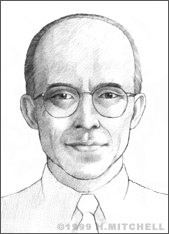Robert Hall
In 1962, Robert Hall created a revolutionary type of laser that is still used in many of the electronic appliances and communications systems that we use every day.
Robert N. Hall was born in New Haven, Connecticut in 1919. After earning a BS in Physics from the California Institute of Technology (Caltech), he took a position with General Electric (GE) at their Research and Development Center in Schenectady, New York. There he contributed to the World War II effort by designing systems that used continuous wave magnetrons to jam enemy radar. After the war, Hall returned to Caltech to earn a PhD in Nuclear Physics (1948). He then returned to GE’s R&D Center, where he spent the rest of his professional career.
Hall’s first major contribution was to develop a technique for the purification of germanium, a metalloid element then used to make transistors. A “chance observation” of the properties of pure, crystalline germanium led him to discover alloyed p-n junctions and to create the “p-i-n” diode. Hall’s diode rectifier was basically a semiconductor used as a “rectifier,” or AC to DC power converter. It led him, in turn, to invent solid state “thyristors,” which are still used as rectifiers today (with silicon replacing germanium), especially in electric locomotives and high-voltage DC electrical transmission.
In 1962, Hall became the envy of his peers when he built the first semiconductor injunction laser (granted patent # 2,994,018 in 1967). He had recently attended a talk on highly emitting diodes, and he realized that a semiconductor junction could support a simpler, more direct type of laser. Hall’s device, based on a specially designed p-n junction semiconductor, allowed for highly efficient generation of coherent light from a very compact source; the semiconductor crystal was only a 1/3 mm cube. The electrons were injected directly by an electric current into the junction, rather than by an external, high-intensity light source.
Today, semiconductor lasers based on Hall’s original design are used in all CD and CD-ROM units, all laser printers, some TV remote controls, and most fiberoptic communications systems.
By the end of the 1960s, Hall had made a number of major advances in solid-state physics. In the 1970s, the energy crisis inspired him to turn his attention to photovoltaics and solar cells. In the 1980s, Hall returned to work on germanium, which he was eventually credited with singlehandedly making “the cleanest material on earth” and, as such, suitable for use in electron-hole droplet experiments and in high quality energy spectrometers for nuclear particle detectors.
Robert N. Hall retired from GE in 1987 with 43 U.S. patents to his credit. Over the past thirty-five years, he has won a number of prestigious awards for his career of invention, including induction into the National Inventors Hall of Fame (1994) and election into the National Academy of Engineering (1977) and the National Academy of Sciences (1948). Since retiring, Hall has devoted himself to a number of educational and community activities, including physics demonstrations for Schenectady students, tutoring the learning disabled, and repairing tape recorders for the Library of Congress Talking Books Program.


